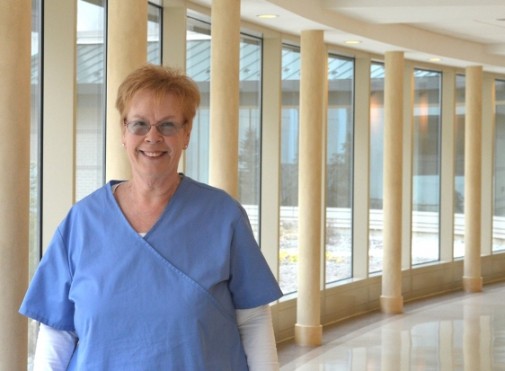Stroke survivor calls treatment a miracle

Arriving home from a holiday party on a cold night last January, Susan Sobanski felt a searing pain knife through her head on the way up the stairs.
The terrible ache forced her stop and sit. “I couldn’t speak and my right side was numb,” recalls Sobanski, a nurse for 23 years at Advocate Condell Medical Center in Libertyville, Ill. “I’ve been in health care long enough to know I was having a stroke.”
Sobanski, 60, is not the typical stroke patient. She’s in generally good health and doesn’t smoke or drink.
Stroke is the fourth leading cause of cancer death and a leading cause of disability, according to the U.S. Centers for Disease Control and Prevention. Nearly 800,000 people in the United States have a stroke each year — resulting in about 130,000 deaths.
Treating a life-threatening stroke
To save Sobanski’s life, she was first rushed to Condell for drug therapy, but her stubborn blood clot causing her stroke required more advanced care.
With her life at stake, Sobanski was airlifted to Advocate Lutheran General Hospital in Park Ridge, Ill., where Dr. Thomas Grobelny, a specialist in interventional neuroradiology, and his team were waiting.
Lutheran had just launched a new interventional neurovascular program, led by Dr. Grobelny.
Sobanski was the first patient.
“We could see the large clot from the CT scan and decided to perform a thrombectomy,” Dr. Grobelny explained.
An extremely delicate procedure, a thrombectomy removes blood clots from arteries in the brain with a balloon catheter. The deflated balloon is passed into the vessel beyond the clot and inflated. It is then pulled back through the artery, scooping the blood clot along with it.
“It took three tries,” Dr. Grobelny recalls, “but we finally got it.”
Dr. Grobelny has performed the procedure nearly 200 times throughout his 15 years in practice. But no two are exactly the same. “This was an awesome outcome,” he says.
Prior to the procedure, Sobanski was not able to move her right arm and leg and had she difficulty speaking. Four hours later, she was able to move both her right arm and leg, and her speech had improved dramatically.
“Everything came right back,” she says. “It was absolutely amazing. It’s really a miracle.”
Dr. Grobelny says Sobanski could have died or been left paralyzed with permanent speech problems without this treatment.
Lynn Klassman, APN, is the stroke coordinator at Advocate Lutheran General and participated in Sobanski’s care. “For me, it was especially meaningful to be able to provide such a high level of care to a fellow nurse.”
“Dr. Grobelny and his team saved my life,” Sobanski says. “I can’t thank him enough for what he did. Without him, I don’t know where I would be. I am in awe.”
Signs of a stroke
Strokes can occur with thunderous pain, like Sobanski’s, or they can be subtle. Here’s what to look for to recognize whether you or someone you know is having a stroke:
- Sudden dizziness, stumbling or other imbalance while walking
- Slurred speech or difficulty understanding others
- Blurred vision in one or both eyes
- Headache, sometimes followed by vomiting
Every second counts during a stroke. Acting F.A.S.T. can help spot the warning signs and reduce the risks of death or disability:
- Face drooping : Does one side of the face droop or is it numb? Ask the person to smile.
- Arm weakness: Is one arm weak or numb? Ask the person to raise both arms. Does one arm drift downward?
- Speech difficulty: Is speech slurred, are they unable to speak, or are they hard to understand? Ask the person to repeat a simple sentence, like “the sky is blue.” Is the sentence repeated correctly?
- Time to call 911: If the person shows any of these symptoms, even if the symptoms go away, call 9-1-1 and get them to the hospital immediately.
More time without treatment means more brain damage. Call 911 right away. Do not wait to see if they symptoms go away or attempt to drive to the hospital.
Related Posts
Comments
One Comment
About the Author
health enews staff is a group of experienced writers from our Advocate Health Care and Aurora Health Care sites, which also includes freelance or intern writers.


















Miracles do exist only a few people experience it.